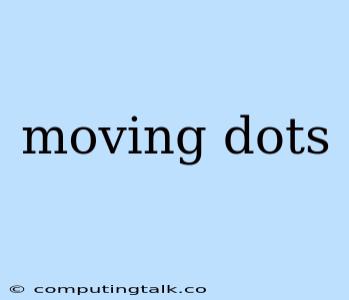The mesmerizing dance of moving dots has captivated viewers for centuries. From the flickering lights of a city skyline to the swirling patterns of a kaleidoscope, these simple yet dynamic elements hold an undeniable allure. But what is it about moving dots that makes them so captivating?
The Science of Moving Dots
Our brains are wired to recognize patterns and movement. When we see moving dots, our visual cortex automatically tries to interpret them, searching for meaning and coherence. This innate ability to process motion is what makes us susceptible to the mesmerizing effect of moving dots.
Think about it: our ancestors relied on their ability to detect movement to survive. Spotting a predator in the distance or a potential food source in the jungle were critical skills for survival. This ingrained instinct to perceive movement is what makes us drawn to the simple beauty of moving dots.
The Power of Illusion
Moving dots can create powerful illusions. One famous example is the random dot kinematogram, which demonstrates how our brains perceive motion from a series of still images. In a random dot kinematogram, a group of dots appear randomly on a screen. When some of the dots are moved in a coordinated manner, our brains perceive a distinct shape or object moving across the screen. This illusion highlights the brain's remarkable ability to create coherent perception from fragmented visual information.
Moving Dots in Art and Design
Moving dots have found their way into various forms of art and design. From the pointillist paintings of Georges Seurat to the mesmerizing animations of Piet Mondrian, moving dots have been used to create stunning visual effects.
In contemporary design, moving dots are often used to create dynamic and engaging user interfaces. Animated moving dots can add a sense of energy and dynamism to websites, apps, and other digital experiences.
Tips for Creating Your Own Moving Dot Masterpieces
If you're feeling inspired to create your own moving dot art or animations, here are a few tips:
- Start Simple: Begin with basic patterns and movements. Experiment with different directions, speeds, and colors.
- Play with Contrast: Use contrasting colors and backgrounds to make your moving dots stand out.
- Add Depth: Use perspective and layering to create a sense of depth and dimension.
- Embrace Randomness: Introduce a touch of randomness to your movements to add a sense of organic flow.
- Think Outside the Box: Don't be afraid to experiment with unconventional shapes and patterns.
Moving Dots in the Future
The possibilities for moving dots are endless. From the realm of art and design to scientific visualization and interactive experiences, moving dots continue to inspire and captivate audiences. With advancements in technology, we can expect to see even more creative and innovative uses of moving dots in the future.
Conclusion
The simple yet profound power of moving dots lies in their ability to stimulate our visual perception and create captivating illusions. Whether in art, design, or scientific visualization, moving dots will continue to play a significant role in shaping our visual world for generations to come.
